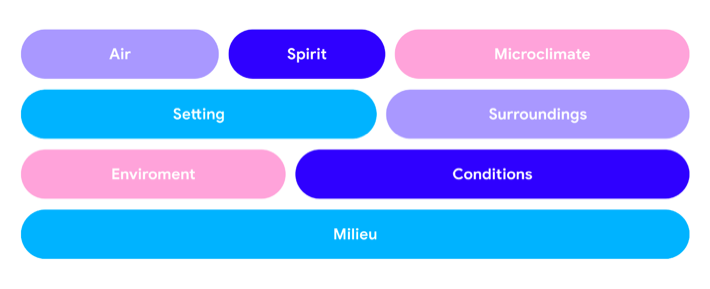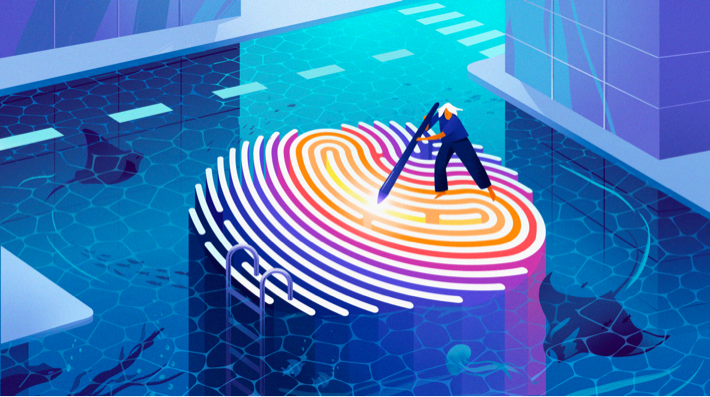
How humans perceive atmosphere depends on the information that the brain receives from sensory organs.
I often find that designers have a rather vague concept of atmospheric design. They think it refers to the mood of a website, emotional design, or to a unique style. Many believe atmosphere is perceived subjectively.
But atmosphere in professional design is an integral part of the general concept. You have to deliberately plan it, instead of hoping it will somehow coalesce by itself.
Knowing what atmosphere is, what it consists of, and how it affects users helps you create attractive projects with high conversion rates.
Let’s recall what we mean by “atmosphere” in everyday life. In fact, designers should take a few hints from this common concept.

Here’s an example. Imagine a lover anticipating a date. What does he do? He lights candles, sets the table, opens a bottle of wine, and puts some music on. He creates a romantic atmosphere that helps him achieve his goals. If it meets the expectations of his date, his chances of reciprocity go up.
The lover takes the exact same steps we use to design an atmosphere:

Any website or app has an atmosphere that users either feel immediately or appreciate gradually. A lot depends on it: whether the user will stay longer or leave; whether they will come back to savor the atmosphere or try to forget it like a nightmare; whether they will remember the website and recommend it to their friends.
Ask them why, and they won’t be able to give you a precise answer. “I just like it (or not).”
The user responds to his or her interactions with a website or app with certain moods, emotions, and feelings. These feelings are the effect, not the cause.
aggressive, repulsive, unpleasant, boring, dull, cold, disappointing, formal, unnatural, fake.
enjoyable, immersive, relaxing, meditative, responsive, sociable, energizing, exciting, captivating, motivating, inspiring, fun.

A designer should not take the user’s view of atmosphere. Our task is to deliberately plot an atmosphere that will meet the requirements of the website/app and resonate with the target audience. Atmospheric design is first and foremost functional.
The romantic example above was not chosen randomly. It perfectly illustrates the main stages of atmosphere creation.
When you enter a store or a café, you immediately feel the atmosphere of the place — before you even know where you are and what’s on offer. You look around the room, hear the sounds and smell the smells, touch the merchandize and the furnishings. In reality, we employ all the six senses at once:
- vision,
- hearing,
- smell,
- touch,
- taste,
- kinesthetics.
Want your design to be atmospheric? Then use all the tools at your disposal and aim to engage the entire spectrum of feelings. It’s not enough to attract the eye!

We don’t yet have the means to make a vanilla-scented culinary app. But we can add a picture of a man enjoying the smell of a freshly baked pie or a video recipe. This will trigger a response in the viewer.
We can’t physically touch the merchandise on a website. But we can give the user the ability to rotate it and see it from different angles, to zoom in, to pick sizes, styles, and colors. We can show a video of a person enjoying the product.
And what about that “button that makes you want to push it”? Design elements that are fun to play with are a great substitute for tactile sensations.
Vision is what we rely on most of all, which is why visual design is the main tool for creating the desired atmosphere. It enables us to conjure feelings that our audience will respond to.
Tip: Remember that the user has six sensory organs, not just the eyes. Look for ways to engage the senses that will be the most helpful in achieving your goals.

In creating an atmosphere, we should always keep in mind the goals and tasks of the project. Once the user gets over their initial impressions (which takes mere seconds), they must immediately understand what is being offered, what the advantages are, and what they’re supposed to do.
There are different kinds of projects; some have short user paths, and others rely on longer ones. The project goal is what determines both the kind of atmosphere and the depth of immersion. The atmosphere must never distract from the goal.
Tip: Decide what kind of atmosphere you need as early as the concept stage. Describe it with words, use examples and associations, test it. A clear understanding of what atmosphere will suit your users best will help you find interesting ideas and effective solutions.
Good UX is the backbone of atmospheric design. Like nitrogen in the air, it’s an essential life-sustaining component. It’s organizing the conditions for the digital product to work and fulfill its function. An interface that invites interaction and immersion. This kind of interface doesn’t need to have easy usability, since its purpose is to delay the user and prolong the interaction. It’s a richly scented air.
Tip: To create an immersive atmosphere, use any available customer retention tools (engaging interactions, responsive interface, helpful functions and widgets, triggers, user investments, rewards, gamification, and sharing options for social media).
Emotional design creates an unforgettable and trustworthy atmosphere. While feelings help the user to assess the situation and get interested, emotions work on a deeper level. The primary tools of emo design are association-based visuals and stories that are exciting to the user/viewer. The best approach is to use images and associations that inspire, motivate, and call to action.
Stories are an integral part of any memorable date. Our lover tells his girl a story from his life. She’s profoundly impressed. “Jeez,” she thinks, “I’ve had the exact same experience! We’re so alike! This was clearly meant to be.”
This is definitely not their last date.
Tip: Study your target audience in depth, create portraits of your users. This will help you find a properly exciting story, as well as the best way of telling it (using words, photos, illustrations, videos, or audio).
Not every “date” is planned to be long and requires in-depth atmospheric immersion. Organizing the conditions that allow the user to easily achieve their goals is an essential part of business atmosphere. This means good usability that leaves a positive impression. A complicated interface makes the atmosphere heavier. Extra steps, unnecessary elements, distracting flourishes — all this is like breathing polluted air. The user feels overburdened and oppressed, the path to the goal becomes hazy. What the user needs is a breath of fresh air.
Tip: Get rid of obstacles and complications, decrease the cognitive load.

This isn’t some distinct style. It’s just an adequate individual design. It meets user expectations and matches the client’s business and product.
Style becomes atmospheric through good UI. This means that:
- The interface is aesthetically pleasing and easy to grasp;
- The color palette creates the desired mental and emotional state;
- The style has harmony, unity, and consistency (both logical and visual);
- The style helps to achieve the project objective;
- All visual elements are functional and justified.

Bad quality can ruin even the most enchanting atmosphere. Let’s say our lover decides to go cheap and serves dinner on a soiled tablecloth: yesterday’s pizza, off-brand wine, and soap-scented candles. Instead of a romantic atmosphere, he creates one of squalor and disrespect for his guest.
The quality of design is very important to the atmosphere. And not just because good design is enjoyable and functional. Good atmospheric design signifies the company’s attitude to the consumer. It shows that the company cares about the user’s needs and comfort. This, in turn, makes users trust both the company and its product. Atmospheric design leaves a pleasant and lingering aftertaste.
Tip: Remember that it’s very easy to ruin the atmosphere with outdated design, low-quality images, and irrelevant content.
